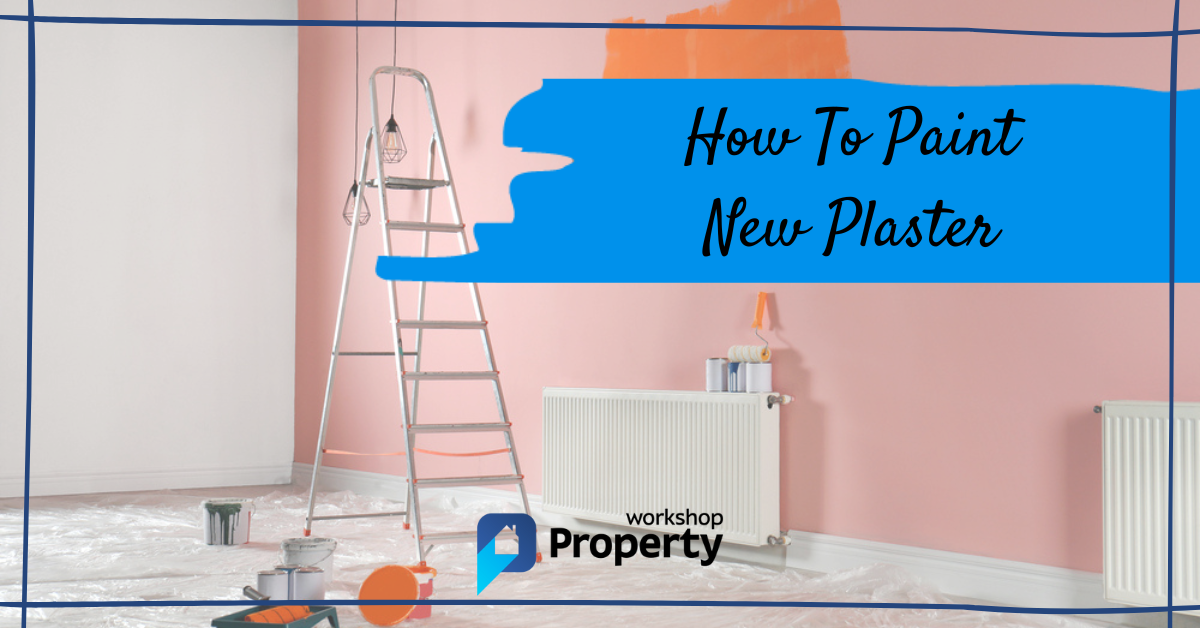Redecorating sometimes involves painting over fresh plaster, which has some key differences from painting over old plaster. In this guide, I’ll explain these differences and how to deal with them.
But before we get into the step-by-step process, below are three questions DIYers often ask when painting new plaster:
- How long should I wait for fresh plaster to dry before painting over it?
- What type of paint produces the best finish on new plaster?
- Should I seal bare plaster with PVA?
In the following sections, I’ll tackle all these questions and more…
Note: This guide only deals with painting INTERNAL walls/ceilings.
Don’t fancy doing this job yourself? Find top-rated painters in your area by clicking the button below:
Tools & Materials
Ensure you have all the tools and materials below before painting over fresh plaster.
Tools
- A canvas drop cloth to protect carpets.
- Scraper.
- Bucket.
- Stirring paddle drill attachment or stirring stick.
- Paintbrush set.
- Roller and tray (medium to tight roller sleeve).
- Filling knife.
Materials
- Plastic sheets.
- Rosin paper to protect hard floors.
- Masking tape.
- Emulsion paint.
- Solvent-based paint for kitchen and bathrooms.
- PVA. Use as a sealer for solvent paints only. For emulsion paint, use mist coats.
- Filler.
- 220-grit sanding block.
Best Paint For Fresh Plaster
Picking the right paint depends on the room, plaster type, and your budget.
Water-based paints (emulsions) soak up the moisture in bathrooms and kitchens, making them unstable and likely to peel or harbour mould spores. Therefore, it’s best to use solvent-based paints in these high-humidity rooms. Some companies even produce special kitchen and bathroom paints designed to handle moisture.
For the other rooms in your home, buy the best emulsion you can afford. High-quality paint requires fewer coats, lasts longer and produces a much better finish when compared with cheap paints.
Painting New Plaster — Step-by-Step Instructions
Follow the steps below to paint your fresh plaster like a Pro!
1. Wait For Fresh Plaster To Dry
Let freshly plastered walls dry out completely before you start painting.
Drying time depends on several factors, such as; time of year, heating, plaster type and the number of plastered layers.
You can expect fresh plaster to be completely dry after about three weeks, assuming you have central heating. If you don’t, it could take up to 6 weeks.
A freshly plastered wall looks much closer to the colour in Fig.1 than in Fig. 2. Once the wall is completely dry, it should match the colour in Fig. 2.


Why Wait For Plaster To Dry?
Don’t paint plaster before it’s completely dry because paint forms airtight skin, trapping moisture underneath and preventing it from evaporating.
This trapped moisture either moves deeper into the plaster, developing mould in the wall, or mixes with wall salts and becomes efflorescence.
In either scenario, you’ll have an expensive problem to fix. As always, prevention is better than cure!
Can I Speed Up the Drying Time?
Ensure freshly plastered rooms are well-ventilated by opening doors and windows. This allows air to flow through the room, gently drying your plaster.
Pro Tip: Don’t be tempted to turn the heating up full whack, as rapidly drying plaster can cause cracking.
2. Preparing the Room
You, or your plasterer, should’ve already prepared the room before plastering. If not, here are the essential steps:
- Move as much furniture out of the room as possible. Any furniture that needs to stay must be covered with plastic sheets.
- Cover hard floors with rosin paper and cover carpet flooring with canvas drop cloths.
- Use masking tape to cover other areas that shouldn’t be painted.
For more info on preparing a room for painting, check out our guide to painting a room without making mess.
3. Remove Excess Plaster (if necessary)
Look closely at the surface; you’ll likely see small plaster drops. They’re not obvious initially but stand out when you’ve finished painting. Use a scraper to remove all the big bits you find.
Lightly sand the plastered surface using a 120–240 grit sanding block. Avoid rubbing one area too much, as you’ll polish the surface or create dips, preventing paint from fully adhering to the plaster.
Regularly check your progress by running your fingertips over the plaster. After you’ve smoothed out the damage, you shouldn’t feel any difference when comparing the sanded and surrounding areas.
4. Seal New Plaster
Fresh plaster is extremely porous, so if you use undiluted paint, the plaster will such up the paint’s moisture. The result is dry paint that won’t bond with plaster.
Therefore, you must seal the plaster before applying the finish coat. For water-based paints, seal the plaster with one or two mist coats. Mist coats are diluted coats of paint that plaster sucks up like a sponge and uses to fill its pores.
For solvent-based paint (recommended for bathrooms and kitchens), use PVA as your sealer.
How To Apply Mist Coats
IMPORTANT NOTE: Do NOT use vinyl emulsion for your mist coat. Vinyl forms a skin on the surface of your plaster that’s prone to peeling.
If using solvent-based paint, follow the instructions below, BUT substitute emulsion for PVA.
1. Mix Emulsion With Water
- If the emulsion packaging includes mist coat instructions, follow them. If not, mix it with water using a ratio of seven parts emulsion to three parts water.
- Stir thoroughly using a stirring paddle attachment for your drill or a stirring stick.
Note: Depending on your emulsion, you may have to alter the above ratio to achieve the right mix. If you need more info, check out this mist coat guide.
2. Apply Mist Coat
- Apply the mix to the plastered surface. Use a brush for the edges and a roller for everywhere else.
- Check the plaster is absorbing the liquid. You may even hear a sucking sound while the plaster absorbs the mist coat.
- If the plaster is not absorbing the mix, add more water to a max mix of 50/50.
- In most cases, one mist coat is enough. However, it doesn’t hurt to add a second one if you want.
5. Fill and Sand any Imperfections
Once the mist coat has dried, fill and sand any imperfections by following the instructions below:
- Mix up some filler.
- Using a filling knife, apply the filler to any holes and cracks and wait for it to dry.
- After the filler has dried, use a 220-grit sanding block to smooth it.
- Touch up the filled areas with the remaining mist coat mix.
6. Apply Topcoats
Once the filler touch-ups have dried, your wall/ceiling is ready for its finish coats.
Apply two or three topcoats following the same mist coat steps.
For more information on painting, check out our guide to painting a room. You’ll find some great tips on using rollers and brushes, so I highly recommend checking this out before you start painting.
Don’t fancy doing this job yourself? Find top-rated painters in your area by clicking the button below:
Final Thoughts
To see how the pros paint new plaster, check out the video below by Charlie DIYte:

FAQ
Below are frequently asked questions we receive about painting new plaster.
What if I cannot wait for my plaster to dry?
If you can’t wait, microporous paints allow the plaster to release moisture and breathe while still drying.
Typically, microporous paints are thinner than water-based and solvent-based paints, so once the surface is dry, I recommend painting over them with emulsion. Remember, only add the extra emulsion coats once the fresh plaster is bone dry.
If you plan to use microporous paints, read the product’s instructions for thinning and applying mist coats to fresh plaster.
Although microporous paints are viable if you’re in a bind, I highly recommend waiting for the plaster to dry out completely before painting.
Do I always have to prepare new plaster before applying a mist coat?
This depends on the skills of the plasterer. You may get lucky and avoid this step, but imperfections can happen no matter how skilled the plasterer is.
Often, you can rectify imperfections such as scratches and lumps using sandpaper. See step 3 for instructions.
Should I apply a second mist coat?
A second mist coat is usually unnecessary, but it doesn’t hurt. So for peace of mind, apply a second coat if it makes you feel better.
Apply the second mist coat using the instructions provided in step 4, and remember to wait 24 hours for it to dry completely.
Once the surfaces are smoothed out, sealed and 100% dry, continue painting the topcoats (step 6).

